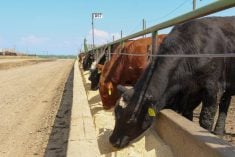Alberta packers were buying fed cattle at $268 on dressed basis in mid-January, which is up $10 from last month. Fed cattle values on a live basis were quoted at $163 in Alberta and US$124 in the U.S. Southern Plains. The market appears to be percolating higher due to tighter than expected market ready supplies.
Wholesale beef prices have been trading in a sideways range due to a seasonal slowdown in consumptive demand. Packing margins have come under pressure but the weekly slaughter pace continues to exceed year-ago levels. The Canadian dollar has strengthened since the December lows, which has tempered the upside for fed and feeder cattle prices.
Read Also

Harvest wraps up and fall work begins
At the Eppich famly ranch in western Saskatchewan, the fall harvest was successful with few breakdowns, cows and calves have been sorted and a new tractor has arrived
The feeder market remains firm, especially for 800-pound-plus cattle. Feedlot margins are slightly in positive territory for the first quarter of 2019, which has been supportive for the replacement market. Calves have been quite variable across the Prairies so far in 2019. There appears to be limited supplies in central and southern Alberta; therefore, feedlots in the Lethbridge area are sourcing from farther distances.
We’ll see a fair amount of fall-placed yearlings marketed over the next month and feedlots will be anxious to reload given the favourable margin structure. In mid January, 850-pound steers were readily selling around $185 in central Alberta while 650-pound steers were quoted from $205 to $210.
During the final quarter of 2018, the U.S. slaughter came in above expectations. Favourable packing margins due to strong wholesale and retail prices encouraged the higher slaughter pace. In addition to the positive economics in the packing sector, feedlot performance was exceptional in Canada and the U.S. as rates of gain were near record.
Cattle were pulled forward in the U.S. and slaughtered sooner than anticipated. Carcass weights were coming in below year-ago levels. In Western Canada, the slaughter also exceeded expectations although market-ready supplies were above year-ago levels. Basis levels for fed cattle were historically weak during December as Alberta prices were at a discount to the U.S. market. We didn’t see a sharp increase in fed cattle exports although the market was encouraging movement south of the border.
Good start for feedlots
This situation has resulted in a favoUrable market environment for feedlots during the first quarter of 2019. U.S. feedlots are in a strong negotiating frame of mind. Keep in mind carcass weights tend to trend lower during the first four months of the year and 2019 will be no exception. Packers will have to slaughter more cattle to satisfy the demand. It’s important to realize, given the placement structure in the U.S. over the past six months, market-ready supplies in April and May have potential to be extremely snug.
U.S. packers are showing fairly strong basis levels for the spring timeframe. In Alberta and Saskatchewan, market-ready supplies will also tighten in February and March due to lower placements of heavier replacements in October and November.
Wholesale beef prices generally trade in a sideways range throughout January and February. This is due to seasonally soft demand in the retail and restaurant sectors. However, in March, beef demand makes a seasonal high as spring conditions enhance demand across much of the U.S.
Wholesale beef prices tend to trade higher during March and April which encourages the weekly slaughter pace. This year, we’ll see the market experience seasonally strong demand in March and April while market-ready supplies are rather snug. This will result in favourable margins for feedlot operators and spillover into the replacement market.
Earlier last fall I was quite bearish on feeder cattle prices and encouraged producers to market their calves sooner rather than later. The March feeder cattle futures made contract highs in early October reaching up to $155.50; however this contract closed at $144.90 on January 11.
I want to point out that U.S. feeder cattle numbers outside feedlots as of October 1 were very similar to year-ago levels. On the recent USDA cattle-on-feed reports, feedlot placements have been below year-ago levels. The U.S market is gearing to experience a surge in feeder cattle placements in March and April as cattle come off small-grain pasture in the Southern Plains. This will result in lower export demand for Canadian feeder cattle.
I’m expecting the Western Canadian feeder market to trade sideways over the next couple months. We may see minor upside in the feeder complex during March and April due to favourable feedlot margins. However, be cautious. This rally is a selling opportunity because of the larger supplies coming on the market south of the border.
















